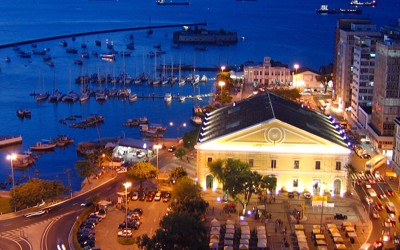 |
 |
Salvador's major arts and crafts shopping location. The Mercado Modelo can be defined as a ‘Model Market’ with its diversity of shops, where one can encounter the most varied types of arts and crafts representative of Bahia. There are 263 shops, amongst them, two restaurants and diverse mini-bars and mini-restaurants, distributed over two levels that occupy the neo-classic styled building, protected by IPHAN, the Patrimônio Histórico e Artístico Nacional (National Historic and Artistic Heritage), built in 1861 to be used as the third Customs House in Salvador. Recognized as one of the main tourist points of Salvador, located in the commercial district of the Cidade Baixa (Lower City), the Mercado Modelo is visited by 80% of the tourists that come to the city. A cultural and artistic space and a gathering place not only for shopping, the Mercado Modelo with its rodas de capoeira (dance-fight circles of Angolan ancestry), and sounds of the berimbaus (musical bows) and caxixis (woven basket shakers), portrays the spirit and animation of Bahia.
|
 |
|
This is an unforgettable place to know in Salvador and a place where one can find arts and crafts and memorabilia of Bahia. Inaugurated on December 9, 1912, the Mercado Modelo functioned as the principal centre of supplies for the city of Salvador. It was the primary location for the commercialization of foods and general goods such as fruits, greens, meats, fowls, fish, flours, salted prawns, the freshly collected peppers, cigars of Recôncavo and cachaças (cane spirits) stored in artesenal containers from all over Bahia. Products that arrived from Recôncavo in the boats and from the small farms that surrounded the city.
|
 |
 |
 |
The first permanent building that established the presence of the Mercado Modelo stood between the Casa da Alfândega (Customs House), nowadays the site of the School of Marine Aprentices, in front of the entrance ramp to the Mercado Modelo. In 1969, the original market construction was completely destroyed by fire. Only in 1971, after one more fire, the Mercado Modelo was changed to the Customs House, the impressive Federal building, and was declared a national historic and artistic monument by IPHAN in 1966. The building reproduces traditional neo-classic forms of the second half of the 19th Century, with a square architectural plan and circular construction behind, which served originaly as a docking point for the ships that transported goods.
|
 |
|
With this change of location, and under pressure from CEASA and the supermarkets that started to proliferate in the cities, the Mercado Modelo changed its commercial focus from food and general products to the sale of handmade arts and crafts and products typical of Bahia, under adminstration by the Municipal Council. The history of the Mercado Modelo is marked by tragedies provoked by great fires. The last of those occured in 1984, already in the current building, that was totally restored in keeping with the original architectural plan. Some modifications were introduced, however, such as pre-moulded concrete forms, a covering of colonial tiles and new fire prevention equipment.
|
 |
 |
 |
Throughout its history, the Mercado Modelo has been marked by fires. The first occurred in 1922, that almost completely destroyed it, forcing the traders to transfer their activities temporarily to other locations. The building was soon after restored so that the flow of supplies to the city would not be interrupted. Only 21 years later in 1943, the second fire occurred causing only partial damage. Yet another fire happened in August of 1969. This time, the building was completely destroyed and the traders were forced to make a definitive relocation. Only on February 2, 1971, after negotiation with the representatives of local, state and federal government, did the Mercado Modelo occupy the Customs House building. The last fire registered occured in 1984 causing serious damage to the building.
|
 |
|
It thereafter passed through a complete restoration once again in keeping with the original architectural plan. Terminating in record time on December 8, 1984, the reform introduced certain modifications, such as pre-moulded concrete structures and a covering of colonial roof tiles. Nowadays, the building posesses modern fire prevention equipment which includes an alarm system, hoses, extinguishers and fire hydrants distributed in all corners of the market. In this way, traders trust the tradegy of 1984 will never again be repeated.
|
 |
 |
 |
On the occassion of the visit of the Royal Family in 1968, the Queen was presented with an artesenal bracelet (Penca de balangandãs) with small symbolic trinkets. The replica of the artefact was sought after by all the visitors who wanted one equal to that given to the Queen. It has become one of the most purchased souvenirs in the Mercado Modelo.
|




